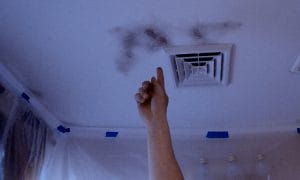 Nothing stops a homeowner in their tracks like discovering a black growth spreading across the ceiling of their house. We have been called to many homes with a panicked and perplexed homeowner with absolutely no idea how this growth that wasn’t there yesterday just showed up. They keep a clean house so how could this possibly happen?
Nothing stops a homeowner in their tracks like discovering a black growth spreading across the ceiling of their house. We have been called to many homes with a panicked and perplexed homeowner with absolutely no idea how this growth that wasn’t there yesterday just showed up. They keep a clean house so how could this possibly happen?
Mold on ceilings and walls has little to do with cleanliness and everything to do with moisture levels. As builders are becoming smarter about air leakage and it’s inevitable energy costs, they are beginning to seal houses up tighter. Unfortunately a tighter house is just one part of building a high performance house and achieving a tighter building envelope without applying all of the high performance a building improvements can create other problems like moisture issues. The causes of the mold vary based on how the house was constructed so evaluation by a licensed HERS Rater is a must to get to the heart of the issue.
The most recent call of this nature that we had was for a beautiful 1.5 M house that was only a couple of years old. The mold was spreading across the bathroom ceiling centered around the bath fan and also in a kitchen cabinet under the cook top which housed the downdraft vent for the cook top.
I know you first reaction is that must be a poor quality bath fan and down draft vent but that was not the case. Further investigation revealed that the builder had rightly installed a conditioned crawl space under the house and supplied conditioned air under the house but no return. The supply was just three large 8 inch diameter holes drilled into the supply trunk, way more than necessary. While this supplied a large amount of conditioned air to the crawl keeping the area relative humidity low enough to prevent the growth of mold, under 60% RH. What this did, however, was put the crawl in a positive pressure state meaning that there was supply air pumped into the area while none was removed. A slight positive pressure in the crawl is preferable because it causes any moisture wicked up into the block work to be driven to the outside. Where the problem arises is when the supplying conditioned air to the crawl causes the house to enter a negative pressure which then draws air in from the outside. Even if great pains have been taken to make the house as air tight as possible, there are always leaks. Even the best bath fans and exhaust fans leak. They have passive back flow preventers that even when closed still leak air. So the last thing you want to do is put the house under negative pressure which then draws the warm moist air during the summer into the house through places like the fans, which then quickly condensates of the the nice cold drywall and cabinets. A HERS rater has equipment to check for pressure differentials and will know how to set the house up to test for these conditions. Address the negative pressure and there will be no more mold. This is just one reason for the mold growth, every house is different. Call us today if you have been experiencing these problems. We would love to help.
